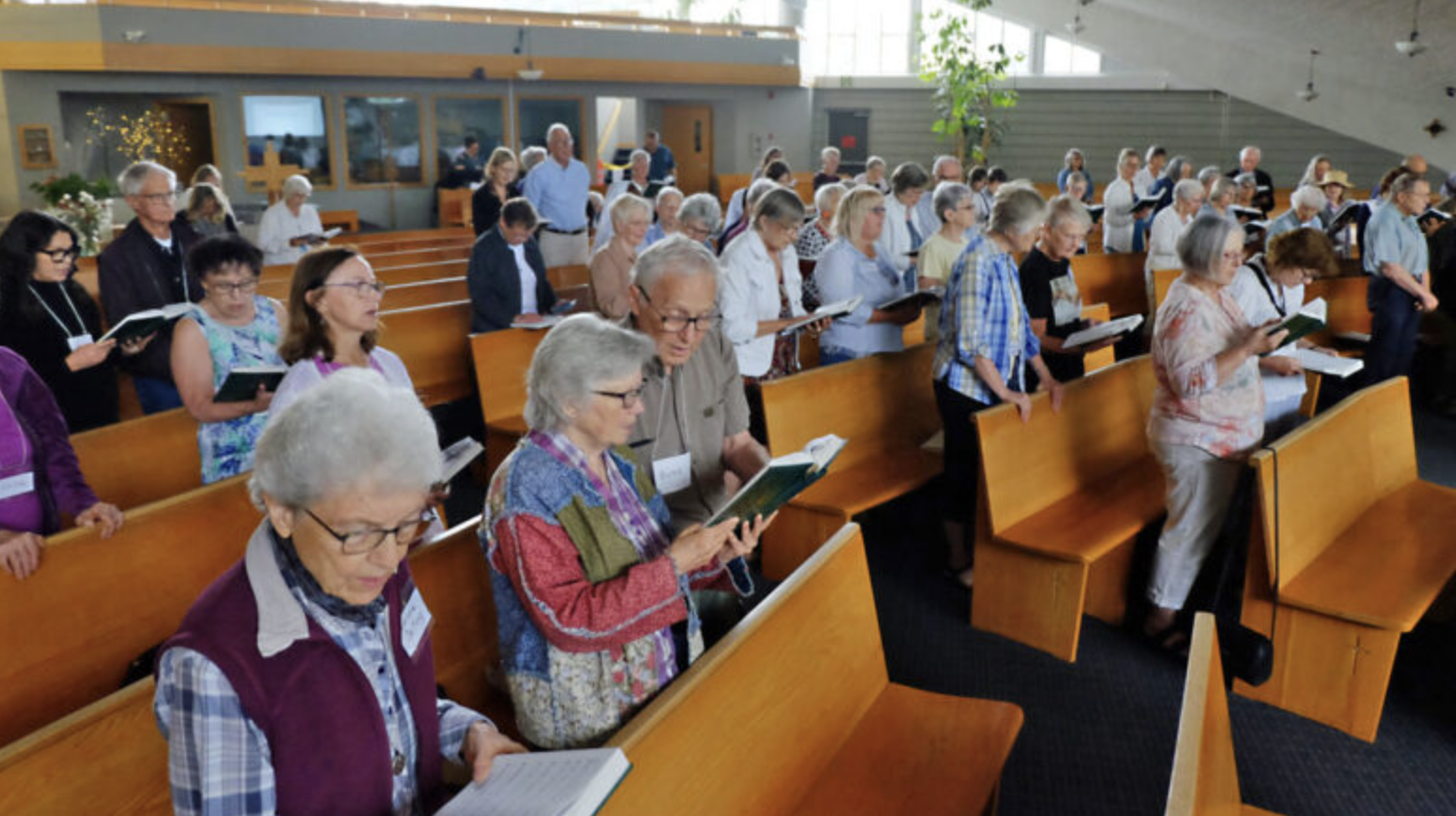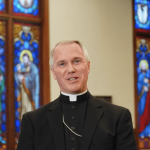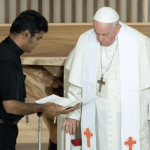SASKATOON, SASK. — The theme of a Festival of Faith held at St. Philip Neri Parish in Saskatoon during this Jubilee Year of Hope was “Sent to Bring Good News to the Poor: Called to Mission Animated by Hope”.
The parish launched the seven-day Festival of Faith July 9 with an opening Mass at which Bishop Mark Hagemoen expressed his appreciation to the local parish for hosting the event one year after the closing of Queen’s House of Retreats, continuing a local tradition of offering a time of spiritual refreshment and renewal in the summer months.
Parish volunteers, leaders, and pastor Fr. Doug Jeffrey, OMI, planned and hosted the time of “community building, faith learning, prayer and faith celebration, socializing and entertainment.”
Celebration of the Eucharist was part of each day of the seven-day Festival of Faith, along with music, hospitality and fellowship.
Faith enrichment sessions grounded in scripture included “Women in Scripture: Preparing the Way and Witnessing to the Resurrection” presented by Deb Rolfes on July 10; as well as a day focused on prayer July 11 that included an introduction to — and experience of — two kinds of prayer: scripture-based Lectio Divina presented by Fr. Doug Jeffrey, and contemplative Centring Prayer presented by Fr. Kevin McGee; and later in the evening, a time of Eucharistic Adoration and Benediction.
On Saturday, July 12, Sr. Cindy Lewans presented “Let it be done unto me” — a reflection on the Blessed Virgin Mary’s trust in God’s love, followed by “Mary: A celebration in song” led by choir members from the parish.
St. Philip Neri pastor, Fr. Doug Jeffrey, OMI, welcomed those assembled for the opening Mass July 9, pointing to both the parish mission of “Joyfully Building Up The Church,” and the diocesan statement that “In All Things We Are Rooted in Christ in His Desire to Bring God To All Peoples.”
Jeffrey added that in this Jubilee Year of Hope we are especially “Sent to Bring Good News to the Poor,” which is the theme of the July 9-15 Festival of Faith, and its focus on mission grounded in the hope of the gospel.
In his homily, Bishop Hagemoen reflected on the issue of growth, healing, and change in our lives, a theme addressed by St. John Henry Newman. “It happens to us all – change, growth, and the journey continues,” the bishop said.
The temptation to indifference — which Pope Francis said is the opposite of love — comes in the midst of much conflict and suffering in the world, Hagemoen said. “And so we don’t engage, we stop caring – why care? Because it hurts too much, or it is too disappointing, or every time we seem to move forward, instead we move backward?” However, as missionary disciples of Jesus Christ, we are called not to indifference, but to love, and to proclaiming God’s good news to the poor, he said.
“The Jubilee Year of Hope is a response,” he added. “Hope is not just an attitude, it is a commitment, because God has shown us that commitment. We would not be here if it was not for the life, suffering, and death of Christ. God has come into our midst…. We need to point consistently to the central way of the Incarnation — not the way of fighting fire with fire, not the way of indifference where we disengage, but by responding with the way of God… Let’s start small with our own hearts,” the bishop urged.
Deb Rolfes, who holds Masters Degrees in English literature and in Hebrew scriptures, gave three presentations on Women in Scripture on Thursday, July 10, giving historical and social context to familiar scriptural stories and insights into how they nurture faith today.
Rolfes began by reflecting on Christ’s reading the passage of Isaiah that he has come “to bring Good News to the poor” from Luke 4 — and the startling message of the Beatitudes in blessing those who are poor, mourning, or struggling. She presented examples of women in scripture that help us understand how pain, difficulty and suffering in our lives can also be blessed times, where in spite of the inevitable pain and suffering of life, the “unspeakable joy” of God’s love and sustaining presence will break through.
She explored “the powerless and the poor” — Sarah and Hagar in the book of Genesis, Jephthah’s daughter in Judges 11:34-39; and Hannah in 1 Samuel — and the “unexpected agency” of Miriam in Exodus 15, and of Deborah and Jael in Judges 4. In her second talk she reflected on the “institutional agency of Jezebel, Hulday, and Esther” and the lives of women who are ancestors of Jesus in the line of David: Tamar, Rahab, Ruth, and Bathsheba.
Rolfes’ third talk delved into the gospel accounts of the unnamed woman with a hemorrhage, the Syrophonecian woman, the Samaritan woman at the well, the widow with only a mite, the disciples on the road to Emmaus, and Mary Magdelene, the first to witness and announce the Resurrection of Christ.
These women demonstrate that “God sustains us in everything we have to live through,” she said. “We are all Hagars.”
The scripture stories are “another tool in our toolbox, so the next time we are overwhelmed by what life throws at us, we can throw ourselves onto God’s mercy,” she said, adding: “We become aware that we are living in God’s love, which brings a little bit of light into our pain.”
On a day dedicated to different prayer forms July 11, Fr. Doug Jeffrey began his session on Lectio Divina or “Divine Reading” of scripture by examining the Vatican II document on sacred scripture, Dei Verbum, and exploring definitions of prayer.
He quoted Dei Verbum: “The Church has always venerated the divine Scriptures just as she venerates the body of the Lord, since, especially in the sacred liturgy, she unceasingly receives and offers to the faithful the bread of life from the table both of God’s word and of Christ’s body. (VD 21)”
As well: ‘“prayer should accompany the reading of Sacred Scripture, so that God and man may talk together; for ‘we speak to Him when we pray; we hear Him when we read the divine saying.’ (VD 25).”
Prayer is “raising our hearts and minds to God,” according to the Catechism of the Catholic Church, Jeffrey added. And prayer which involves more than our hearts and minds, and includes our bodies, emotions and senses, helps us to meet Jesus, he added.
He explained that Lectio Divina begins with reading (lectio) a passage of scripture and listening for a word to receive and savour; then continues with reflecting (meditatio) on what surfaces and where the Word touches one’s life. “God who dwells within… the Body of Christ is in the person next to us,” he said.
This is followed by responding (oratio) to deepen connection with the Word of God and give permission to be changed by God. “Prayer is about change and conversion,” he said.
The next step is to rest (contemplatio) being with God in silence. “Imagine God looking at you with love, holding you in His arms, sitting beside you in a quiet place,” he suggested.
Finally, there is becoming (operatio), taking all that has happened and put it into practice in daily life: “a time of thanksgiving and action.”
In the second half of his session, Jeffrey offered participants an experience of Lectio Divina, praying with the Gospel about the Annunciation from Luke 1:30-38.
In a presentation on Centring Prayer July 11, Fr. Kevin McGee described the contemplative prayer tradition of cultivating friendship with Christ. He began by asking those in attendance how they reacted to the idea that they were “born to be a mystic.”
“God’s first language is silence,” he said, quoting the Trappist priest Fr. Thomas Keating. “Everything else is a bad translation.”
How we answer the question “what is prayer?” will determine how we pray, he suggested. Moving beyond prayer as “asking,” prayer is about a relationship with God; in service of a relationship with God, McGee said.
Centring Prayer is listening to the Divine Presence within — and is considered to be a “pure gift of God” — beyond thoughts and words, he said.
When asking children “where does God live?” they will answer “in heaven,” and point to the sky. Instead, McGee invites them to put a hand over their heart: “This is God’s address… you are God’s postal code.”
God takes the initiative to love us and live in us, he said, and contemplative prayer is opening one’s self to that reality.
McGee gave an overview of the guidelines for centring prayer, including choosing a sacred word as a symbol of one’s consent to God’s presence and action; sitting comfortably with eyes closed in silence; and when engaged with thoughts or distractions returning gently to the sacred word.
An experience of Centring Prayer in 20 minutes of silence was then offered to those assembled for the session.
Sr. Cindy Lewans of the Sisters of the Presentation of Mary presented “Let it be done unto me,” a reflection on scriptures about Zechariah, Elizabeth, and the birth of John the Baptist, and the Angel Gabriel’s Annunciation to Mary, in particular, about the generous, courageous response of Mary to the love of God.
Lewans explored how the greeting “full of grace,” reflecting on how grace is a free, unmerited gift of God of God’s self — suggesting that the whole meaning of the text is how grace is also a gift for each of us. “And it’s personal,” she said. “Grace is free and undeserved help and love; a participation in the gift of the Spirit.”
“That is hope for us… a lot of hope for us,” said Lewans, who presently works as an associate chaplain at Sherbrooke Community Centre in Saskatoon.
The good news is that “God’s salvation works in imperfection,” she said. “Grace doesn’t mean life will be a bed of roses, but God’s grace is there for us.”
She added: “We can’t conceive how infinite God’s love is: it is faithful and it is sustaining us even when we can’t feel it and when we are saying ‘where are you God?’”
Mary does not dismiss what the Angel says, even though she is perplexed. “Mary ponders these things. She treasures these things in her heart,” said Lewans. “Pondering is – with the help of God’s Spirit – letting the situation be transformed.”
Like Mary, “God comes to each one of us, saying ‘I need you to help enflesh this dream of the Kingdom… I need you to enflesh and encounter God’s life in the world,’” she continued. “We can’t do it, but with God — we can… for nothing is impossible with God.”
She pointed to the refrain of the song by Daniel Schutte “Blessed be the name of Mary, she who trusted the love of God,” adding “this is our ongoing work, trusting in the love of God.”
“What might it mean to say ‘here I am — in this place and situation — your servant, Lord, how can I live in your grace?’”
Following her presentation, members of the St. Philip Neri choir led the singing of Marian hymns in a “celebration in song.”
The Festival of Faith continued with weekend Mass celebrated at the parish 5 p.m. Saturday, July 12 and 7 p.m. Sunday, July 13.
Fr. Ron Rolheiser, OMI — who for many years provided summer retreat sessions at Queen’s House in Saskatoon — was the featured speaker from July 13-15 on the theme “Called to Mission,” which started at 7 p.m. Sunday, July 13, and then continued with sessions at 9 a.m. and 2 p.m. Monday, July 14, and concluded with a final session at 9 a.m. Tuesday, July 15.
Mass was celebrated at 11 a.m. on both July 14 and July 15.
There was also a classical concert with Matthew Praksas on piano and Wagner Barbosa on violin, which started at 7 p.m. Monday, July 14, followed by a reception.




